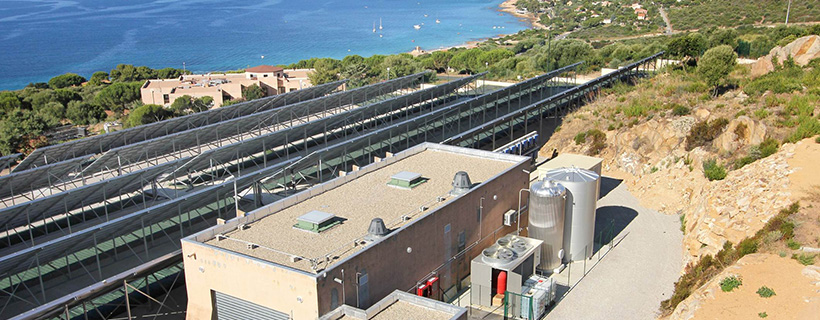The global fanbase of solar energy is steadily increasing, with governments, people and business all over our planet recognizing the green and clean benefits of generating power with solar energy.
Yet, in spite of its green and clean benefits, solar energy also has some negative impacts on the environment, especially with regards to greenhouse gas emissions.
In this article, we will have a closer look at the environmental impact of solar energy.
What is the greenhouse effect?
The greenhouse effect describes the warming effect of heat trapped by a greenhouse gas (GHG) between itself and the earth’s surface.
There are various greenhouse gases that can be found in the earth’s atmosphere in varying quantity. The major
greenhouse gases the atmosphere of our “blue planet” deals with are:
- water vapor (H2O)
- carbon dioxide (CO2)
- methane (CH4)
- nitrous oxide (N2O)
- ozone (O3)
- chloro fluoro carbons (CFC)
The main contribution to warming on earth (a 2010 estimate) comes from water vapor and clouds (75%), followed by carbon dioxide (20%).[1]
Methane is another major greenhouse gas with around 5 – 10%, ahead of ozone which contributes to around 3 – 7% of the greenhouse gases, leaving the rest shares of the whole GHG cake to some other gases and aerosols.
The greenhouse effect of the greenhouse gases was originally a blessing of nature, because without these the average atmospheric temperature would be much lower and make life on earth more difficult for many species.
At the same time, however, if the effect increases even slightly, the temperature will rise (global warming), and threaten human life.
The industrial revolution followed by a steadily expanding industrialization and a vastly growing population on earth have triggered an increase of greenhouse gases in the atmosphere.
Quantifying the environmental impact: Greenhouse Gas Equivalent
To start with: usually some fossil fuel must have been burnt to produce the infrastructure for a given type of energy. In this regard, there is an involvement of non-environmental friendly means to “create” solar energy with its related environmental impacts.
The environmental impact of solar energy is not very simple to define. One quantitative measure, the most common and most convenient one, is the greenhouse gas emission caused by its production.
The mass of greenhouse gases produced to set up, say, a solar PV system, divided by the expected total energy output expected during the life cycle of the (total) system is called the greenhouse gas equivalent (GHGe) of a PV project.
It is estimated that with current technology, PV equipment produces 46 gram/kWh of energy produced by it when averaged over the life cycle of this equipment. In other, simple words: the GHGe of PV is 46g/kWh.
What this means is that the mass of GHG produced by all processes involved in the production and use of solar PV modules and balance of the system, divided by the total PV energy in kWh produced by the system, is 46 gram/kWh averaged over the complete life cycle of the system.
So, while there is indeed a quantifyable environmental impact of solar PV energy, how does it compare to other forms of energy generation?
Comparing the GHGe of solar PV with other types of energy
In comparison to solar PV, the GHGe of solar thermal is currently estimated at around 22 g/kWh. It is expected that with improvement in manufacturing processes, and use of more solar energy in the production processes, the GHGe of solar thermal will drop further to 15g/kWh.
Nevertheless, the current and future figures for solar PV compare very favorably with a combined cycle gas power plant which has GHG equivalent of 400g to 600g/kWh. Oil power has a GHGe of 893g/kWh; and coal power is rated at 513g – 994g/ kWh.
If we use solar PV instead of oil to generate energy, for every kWh we avoid emission of 893g/ kWh minus 46g/ kwH = 847g/kWh of GHG. That is a huge reduction in GHG emission (compared to oil energy).
On the other hand, nuclear, wind and hydro power have much smaller footprints than even solar thermal power…
Nevertheless, the huge reduction in GHG emission is one of the prime reasons for the drive towards alternate energy of which solar energy is an important one.
These emission figures are averages. Actual values depend on the actual implementation of a project. As technology improves, GHGe of solar energy will also reduce, increasing the value of emission reductions.

Environmental impact of defect solar PV module waste from production
Other factors that influence the environmental impact of solar PV
In addition to the direct GHG effect of solar equipment production, there are other factors as well:
- toxic metals: cadmium is used in Cadmium Telluride (CdTe) thin film PV modules, but the amount is about 5-10g/ m2. The overall GHG effect is in micrograms/ kWh which is negligible if proper care is taken. Another toxic element, lead, is part of the solder. The GHG equivalent is negligible here as well, and in any case, lead is not a necessity for soldering.
- threat to birds: this can come from high power beams generated by concentrated solar power (CSP) systemswhen when birds cross the high power beam path.
- land use: footprint of rooftop PV was estimated at 0.59m2/ MWh compared with 7.9m2/ MWh for large scale solar PV farms; and 9m2/ MWh and 16m2/ MWh for large scale CSP systems using dishes and towers, respectively. For comparison: coal power the land use foot print is quoted at 18m2/MWh.
- deforestation/ tree cutting: closely linked to the effect of land use, deforestation also is – even though minor – environmental impact of solar PV energy, especially with regards to solar farms. Trees are in such cases not only cut to make place for the land to build the system on, but also to reduce the shading effects.
- PV waste: this is an effect that comes in many forms: not only do the multiple industrial processes involved in creating PV modules, inverters, mounting systems etc. also create waste of unusable and/ or damaged rest material, but also the PV products themselves at the end of their life cycle. PV Cycle has for example in over 5 years recycled over 13 tons of PV modules. Even though there are electronic waste (e-waste) regulations in place in some parts of the world, such as the Waste Electrical and Electronic Equipment (WEEE) Directive in the European Union (EU), however they fail to cover all of the PV waste that piles up over the years. In addition to this, even if successfully recycled, the recycling rate is close to but not fully at 100%. And of course not to forget: PV waste in form of damaged or low quality modules at manufacturers that never leave the factory.
Sources:
1) Gavin A. Schmidt, et al (2010): The attribution of the present-day total greenhouse effect






